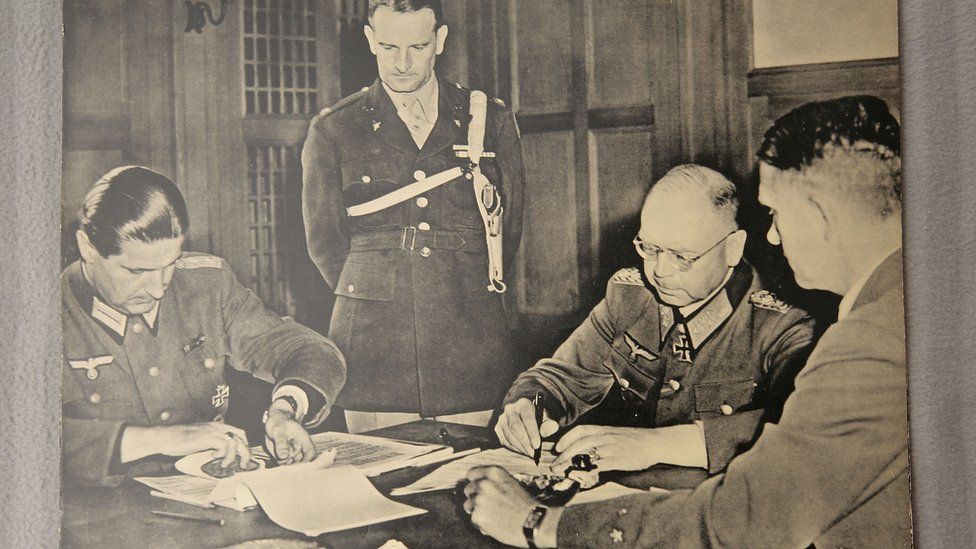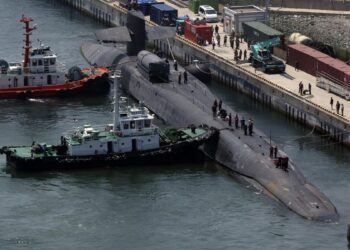On April 25, 1945, Soviet forces encircled Berlin, the German capital. On the same day, Soviet forces joined forces with American forces attacking from the west in central Germany (Torgau). After intense fighting, Soviet forces were closing in on Adolf Hitler’s command bunker in central Berlin. Hitler committed suicide on April 30, 1945. The Soviets took Berlin in a matter of days. On May 7, 1945, German armed forces surrendered unconditionally in the west, and on May 9, 1945, in the east. Victory in Europe Day (V-E Day) was declared on May 8, 1945, with celebrations taking place in Washington, London, Moscow, and Paris.

On this day in 1945, Gen. Alfred Jodl, representing the German High Command, signed a document unconditionally surrendering all German military forces, which went into effect the next day, effectively ending World War II in Europe. The signing ceremony took place at Reims, in northwestern France, at the Supreme Headquarters of the Allied Expeditionary Force (SHAEF).
Scenes After Hitler
Hitler had named naval admiral and ardent Nazi Karl Dönitz as his successor in the event of his death. Dönitz was fated not to rule a new Germany, but to orchestrate its demise. He quickly delegated Alfred Jodl, chief of the operations staff of the Armed Forces High Command, the task of negotiating the surrender of all German forces with General Dwight D. Eisenhower.

Dönitz hoped that the negotiations would buy him enough time to move as many Germans and troops as possible out of the way of the advancing Russians. He also hoped to persuade the United States, Britain, and France, all of whom distrusted the USSR, to turn against it so that Germany could continue its war on that front. Eisenhower, on the other hand, saw through the ruse and insisted on Jodl signing an instrument of surrender without any negotiations. He quickly delegated Alfred Jodl, chief of the operations staff of the Armed Forces High Command, the task of negotiating the surrender of all German forces with General Dwight D. Eisenhower.
Eisenhower informed Jodl that he would close the western lines to German troops, forcing them to surrender to the advancing Soviets on the Eastern Front. Jodl communicated Eisenhower’s ultimatum to Donitz in Flensburg, a remaining enclave on the Danish border. Donitz sent a signal to Jodl shortly after midnight authorizing the complete and total surrender of all German forces.
Stalin’s Objection To The Surrender
When Soviet Premier Joseph Stalin learned that Germany had signed an unconditional surrender of all of its troops in Reims, he became enraged. He argued that because the USSR had sacrificed the most troops and civilians during the war, its most important military commander, rather than the Soviet officer who witnessed the signing in Reims, should accept Germany’s surrender. Stalin was also opposed to the signing’s location, arguing that because Berlin was the capital of the Third Reich, it should be the site of its surrender.

But Stalin’s third objection, that Jodl was not Germany’s most senior military official, would be the most persuasive to the rest of the Allies, who all remembered how the signing of the armistice that ended World War I had helped sow the seeds of the next world war.
Because Jodl was deputized by Dönitz, a civilian head of state, Stalin argued that allowing him to surrender to Germany during World War II could create a new stab-in-the-back myth. Worried that Germany would claim that the surrender was illegitimate if anyone other than Field Marshal Wilhelm Keitel, the supreme commander of all German forces, signed the document, the Allies decided to reenact the surrender.
The Signing
Eisenhower’s chief of staff, Gen. Walter Bedell Smith, signed for SHAEF, while French Gen. Francois Sevez and Soviet Major General. Ivan Susloparov signed as witness. The Kremlin called for a second four-power surrender ceremony on May 8 in a former German Army engineering school in Berlin’s Karlshorst district. (It now serves as the home of the German-Russian Museum Berlin-Karlshorst.) Victory-in-Europe (V-E) Day was declared on May 8, and it is still observed as a public holiday in some European countries, including Russia.

Keitel traveled to Karlshorst, a Berlin suburb, on May 8 to sign the document in front of Soviet Marshal Georgy Zhukov and a small Allied delegation. However, Keitel argued a minor point, hoping to add a clause allowing his troops at least 12 hours to ensure they received their cease-fire orders before facing any penalties for continuing to fight. Zhukov eventually made a verbal promise to Keitel but refused to grant his request to add the clause. Because of the delay, the document was not executed until after the ceasefire was supposed to begin—on May 9, which had already passed.
Victory-in-Europe (V-E) Day, is a public holiday observed in some European countries, including Russia.
Also Checkout: In Sweden violence over right-wing political organisations’ taking out anti-Islamic rallies












